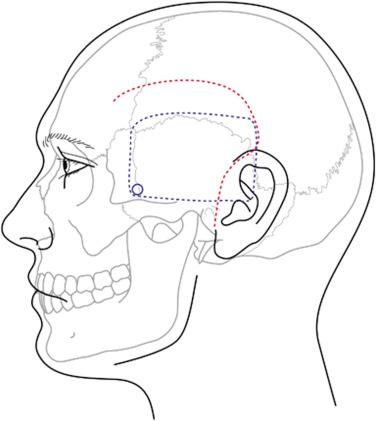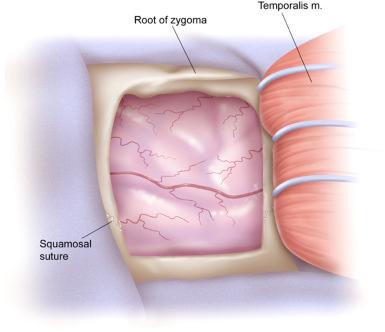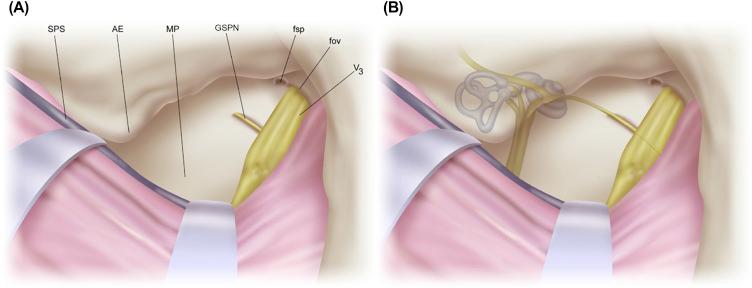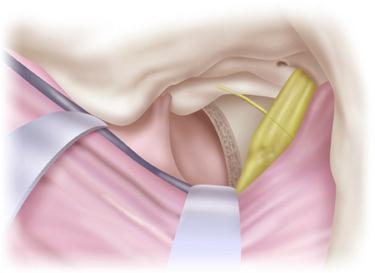Physical Address
304 North Cardinal St.
Dorchester Center, MA 02124
© 2018 Elsevier Inc. All rights reserved. Please note that the copyright for the original figures submitted by the contributors is owned by Contributors.
Lateral approaches to the central skull base traverse the floor of the middle cranial fossa en route to tumors of the anteromedial half of the petrous bone, petroclival region, superior half of the clivus, and upper medial aspect of the cerebellopontine angle. They include the standard middle fossa approach to the internal auditory meatus and a series of progressively larger openings characterized as extended middle cranial fossa approaches. The basic middle fossa approach, as originally described by House, involves relatively limited removal of bone about the internal auditory meatus. The extended approaches dictate removal of some portion of the apical petrous bone. The extended middle fossa or “anterior transpetrosal” approaches provide fenestration in the petrous bone that opens a window into the posterior fossa framed by the inferior petrosal sinus below, the clivus medially, the petrous carotid anteriorly, the cochlea and superior semicircular canal laterally, and the superior petrosal sinus and petrous ridge posteriorly. Common to these routes is an attempt to preserve hearing. This general strategy should be distinguished from the anterolateral route, which requires a frontotemporal craniotomy with resection of the sphenoid wing and anterior clinoid process (see Chapter 14 ) and from the lateral–inferior route that traverses the infratemporal fossa and violates the temporomandibular joint (see Chapter 16 ). The anterior transpetrous route can be combined with these approaches when necessary.
The middle cranial fossa approach is an extradural, subtemporal approach to the internal auditory canal (IAC) and meatus and the immediately adjacent lateral cerebellopontine angle cistern. The limits of bone removal are the cochlea and horizontal petrous carotid artery anteriorly and the semicircular canals and petrous ridge posteriorly. This approach is essentially indicated only for intracanalicular acoustic neuromas and is of limited utility in cases of chordoma or chondrosarcoma. Occasionally, it is indicated for biopsy of a central petrous lesion.
The patient is placed in either the supine or lateral position (depending mostly on the flexibility of the patient’s neck) with the head turned contralaterally such that the sagittal plane is parallel to the floor. Facial nerve electromyelography and brainstem auditory evoked potentials are typically monitored. One of the following three incisions is chosen: a linear one from the preauricular skin crease to the superior temporal line, one in the shape of an anteriorly open question mark from the preauricular skin crease to the superior temporal line, or an inverted U-shaped incision with the anterior limb in the anterior temporal hairline and the posterior limb 2 cm behind the ear ( Fig. 15.1 ).

For the first, the temporalis fascia and muscle are incised in line with the incision and retracted anteriorly and posteriorly ( Fig. 15.2 ). For the second, they are incised in the line of the skin incision and retracted anteriorly. For the U-shaped incision, they are included in the scalp flap and retracted laterally and inferiorly. A 5 × 5-cm craniotomy based on the lateral middle cranial fossa floor is placed 3 cm anterior and 2 cm posterior to the external auditory meatus. Epidural tackup sutures, if needed, are placed only superiorly so as not to restrict subsequent elevation of the dura. Any remaining lateral wall of the middle cranial fossa is drilled away such that the craniotomy is flush with the middle fossa floor and bone wax is applied to the margins of the craniotomy. This is especially important when entrance into air cells poses the risk of postoperative cerebrospinal fluid (CSF) leakage.

Elevation of the dura from the floor of the middle cranial fossa begins posterior, just behind the level of the external auditory canal. The petrous ridge is exposed and followed medially toward the arcuate eminence. Dissection continues medial to the arcuate eminence to expose the meatal plane.
The medial limit of exposure is the lateral margin of the trigeminal impression. The dura is then elevated in the anterior direction to expose the greater superficial petrosal nerve (GSPN) and the middle meningeal artery at the foramen spinosum. The GSPN lies in the major petrosal groove and courses obliquely across the floor toward the lateral margin of the trigeminal third branch. Elevating the dura in this way, from posterior to anterior, helps prevent traction on the GSPN, which could result in injury to the facial nerve. The GSPN becomes visible at the facial hiatus, where it exits a short bony canal ( Fig. 15.3 ). In some cases, the geniculate ganglion is exposed, with no bony covering of the ganglion or the first portion of the GSPN. Failure to recognize this variation can result in injury to the facial nerve. Temporal elevation is maintained by self-retaining retractors whose tips are set on the medial edge of the prominence in the petrous ridge. Epidural bleeding is controlled by placing Surgicel (Johnson & Johnson, Piscataway, NJ, USA) at the anterior and posterior margins of the exposure and, if needed, coagulation of the middle meningeal artery and its surrounding venous plexus.

After the middle cranial fossa floor is exposed, the orientation of the IAC is approximated by one of the following methods: (1) approximating the long axis of the IAC as a line that bisects the angle between the long axes of the arcuate eminence and the GSPN, (2) following the GSPN to the geniculate ganglion and then drilling along the labyrinthine segment of the facial nerve to the canal fundus, or (3) beginning drilling into the surface of the apex of the petrous bone and proceeding posteriorly until the anterior margin of the canal is encountered. When the canal is located, bone is removed from its anterior, posterior, and dorsal surfaces, moving from lateral to medial ( Fig. 15.4 ). Care must be taken laterally to avoid injuring the cochlea anteromedially and the superior semicircular canal posteriorly.

After this exposure, tumors within the canal can be removed and tumors infiltrating nearby the petrous bone can be biopsied or removed. Closure consists of waxing all petrous air cells opened during drilling of the walls of the canal, placing a piece of fat or muscle in the osseous defect, releasing the retractor, ensuring epidural hemostasis, reinserting the bone plate, and closing the soft tissue in multiple layers.
Advantages of the middle cranial fossa approach include its predominantly extradural nature and the opportunity to preserve hearing. Its disadvantages include risk of injury to the facial nerve, cochlea, superior semicircular canal, GSPN, and petrous internal carotid artery (ICA). Except for specific indications, the limited exposure provided by this approach (1 cm 2 ) is quite constraining. Removal of additional petrous bone is often required.
The extended middle cranial fossa approach, also termed the anterior transpetrosal approach , significantly expands access to the cerebellopontine angle cistern and midclivus. Its earlier forms involved only removal of the petrous apex immediately anterior and posterior to the internal auditory meatus to facilitate resection of vestibular schwannomas with limited posterior fossa extension. Subsequent modifications have demonstrated the ability to accomplish an extensive anterior petrosectomy through a subtemporal route. The anterior petrosectomy, performed extradurally or intradurally, can include bone from beneath the trigeminal nerve and ganglion, providing access to the posterior cavernous sinus. In addition, the petrosectomy can be expanded inferomedially from the IAC to the inferior petrosal sinus. Opening the exposed posterior fossa dura provides access to tumors in the ventrolateral cisterns around the midbrain and pons, the superior half of the clivus, and the posterior aspect of the cavernous sinus. The extended middle cranial fossa approach in its maximal form is described in the following section.
Preoperative assessment of the tumor and the surrounding anatomy should include T2-weighted magnetic resonance (MR) images, T1-weighted MR images with and without contrast enhancement, MR angiography, and bone window and soft tissue windowed computed tomographic (CT) scans with and without contrast enhancement. An audiogram and a test of brainstem evoked responses are performed to establish baseline function.
The critical neural structures exposed in this approach are the temporal lobe, the midbrain and pons, and the third through sixth cranial nerves. The intrapetrous structures to be preserved are the labyrinth, the cochlea, and the seventh and eighth cranial nerves throughout their courses. The petrous and intracavernous ICA and the basilar artery trunk and all its branches are the vascular structures of concern. The relationship of the genu of the petrous ICA to the cochlea and the geniculate ganglion, best depicted by the bone window CT scan, is crucial.
In the operating room, the third, fifth, sixth, and seventh cranial nerves are monitored as necessary, and the auditory evoked responds are also monitored. The patient is placed either supine or lateral, depending on the flexibility of the neck. Supine positioning usually mandates supporting the ipsilateral shoulder with a cushion to relieve strain on the neck and to ensure adequate venous drainage. It is advantageous to elevate the vertex slightly, no more than 15 degrees, to aid in exposure during drilling. The abdomen or lateral thigh is prepared as a donor site of fat and fascia for closure.
A curvilinear skin incision is extended superiorly from the preauricular crease, turned posteriorly above the pinna, then superiorly again before turning anterior along the superior temporal line toward the external orbital angle, ending within the hairline ( Fig. 15.1 ). A scalp flap that includes the pericranium and the superficial layer of the temporalis fascia is elevated. The parietal branch of the superficial temporal artery is sacrificed in the preauricular area, but the frontotemporal branch in the soft tissue flap is preserved. Anteriorly, the frontal branches of the facial nerve are protected by the superficial fat pad in the scalp flap.
In most cases, mobilization of the temporalis muscle from the root of the zygomatic process and retraction of the muscle anterior will result in an unobstructed view, flush across the middle fossa floor. The periosteum over the zygoma root is incised and elevated, leaving a cuff of periosteum inferior. The temporalis muscle then is separated subperiosteally from the zygoma. The temporalis muscle is elevated from the temporal squamosa in an inferior to superior direction to preserve the periosteal layer deep to the muscle. This technique serves to protect and preserve the neural and vascular supplies on the deep surface of the muscle. The muscle then is retracted in the anterior direction.
In selected cases, a zygomatic osteotomy is advantageous in providing a more anterior exposure of the middle fossa floor and a lower viewing angle. The zygoma is exposed in the subperiosteal plane, and osteotomies are made at the root of the zygomatic process and anteriorly at the zygomatic–maxillary suture. The deep temporalis fascia is separated from the lateral rim of the orbit, and its superior margin is divided so as to leave a cuff for closure. The temporalis muscle is elevated from the temporal squamosa in an inferior to superior direction and retracted laterally and inferiorly through the gap opened by the zygomatic osteotomy.
A temporal craniotomy centered roughly two-thirds anterior and one-third posterior to the external auditory meatus is made. The dimensions are roughly 5 × 5 cm, similar to the standard middle fossa approach. The inferior margin of the craniotomy is extended to the floor of the middle fossa to remove any obstruction and waxed to close all air cells opened. A more inferior exposure, not usually needed, can be obtained by opening the temporomandibular joint capsule, separating the condylar fossa from the meniscus of the joint, and removing the lateral temporal squama down to the infratemporal fossa. With the craniotomy completed, the operation can proceed either intradurally or extradurally.
Become a Clinical Tree membership for Full access and enjoy Unlimited articles
If you are a member. Log in here